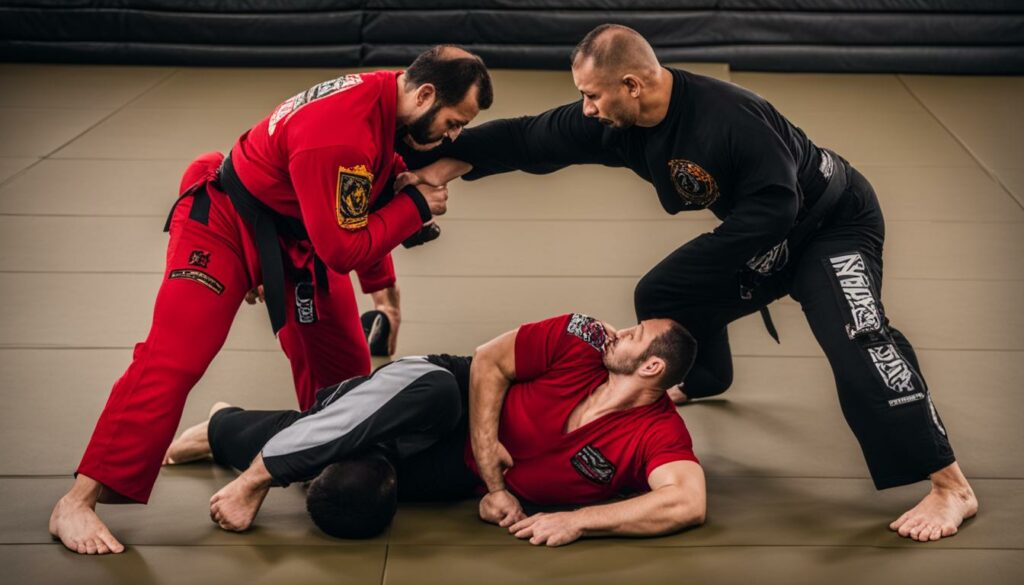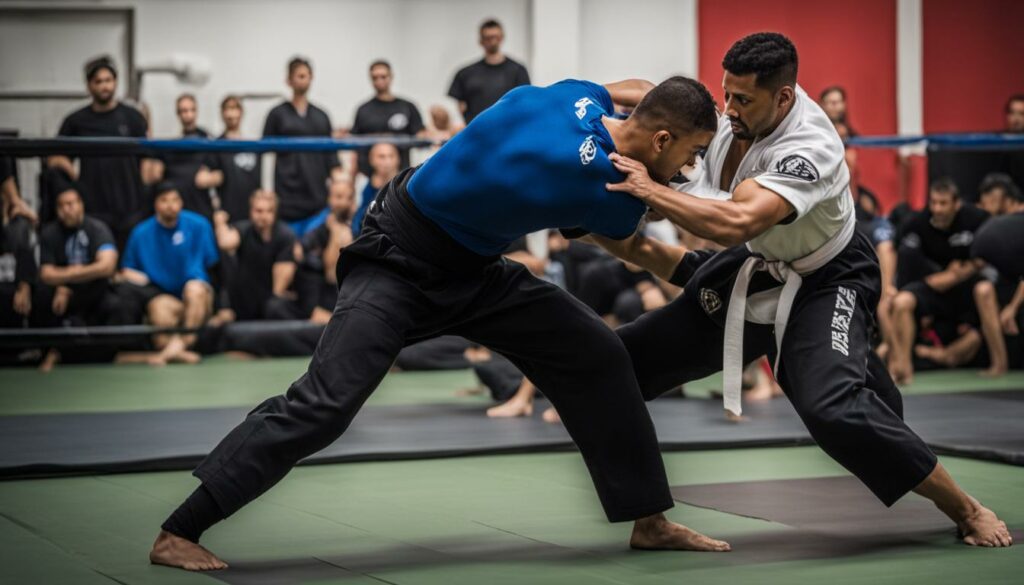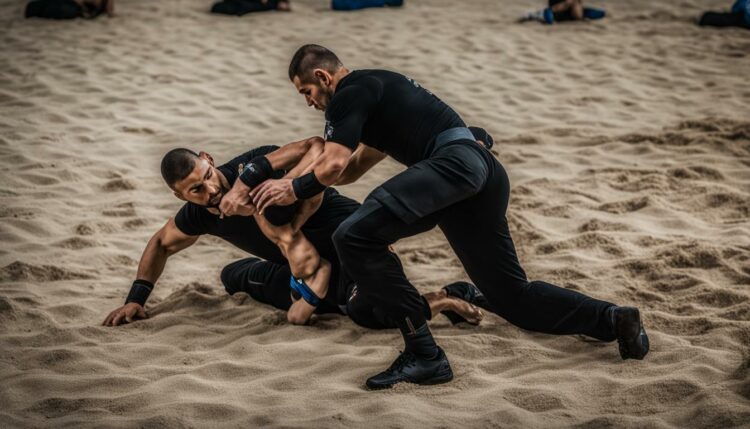Discover the truth about grappling techniques in Krav Maga and how they contribute to its effectiveness as a self-defense system.
Krav Maga, a renowned self-defense system originally developed for the Israel Defense Forces, combines various martial arts techniques to create a comprehensive approach to personal protection. But does Krav Maga include grappling techniques? Let’s explore.
In this article, we will delve into the principles of Krav Maga, compare it to Brazilian Jiu Jitsu, discuss the benefits of grappling, and explore the system’s training methods. By the end, you’ll have a clear understanding of how grappling plays a vital role in Krav Maga’s effectiveness.
The Principles of Krav Maga
Krav Maga follows a set of principles designed to quickly neutralize a threat. These principles include using strikes, holds, and blocks to defend against an attack while simultaneously counterattacking. Krav Maga also emphasizes continuous motion and the use of weapons of opportunity. The system teaches techniques for ground fighting, providing individuals with the skills to defend themselves in various scenarios.
One of the key principles of Krav Maga is the concept of simultaneous defensive and offensive actions. Rather than solely focusing on blocking or avoiding an attack, practitioners of Krav Maga are trained to deliver counterattacks in order to quickly neutralize the threat. This approach is particularly effective in real-life self-defense situations where speed and efficiency are crucial.
Another principle of Krav Maga is the emphasis on continuous motion. Unlike traditional martial arts that rely on static positions, Krav Maga promotes dynamic movements to quickly overcome an assailant. Practitioners are taught to react instinctively and flow from one technique to the next, ensuring that their defense is always proactive rather than reactive.
In addition to strikes and blocks, Krav Maga incorporates grappling techniques to address close-quarters combat and ground fighting. By learning these techniques, individuals gain the ability to control an attacker on the ground, escape from dangerous positions, and effectively defend themselves in scenarios where strikes may not be feasible.
Incorporating Ground Techniques
One of the unique aspects of Krav Maga is its inclusion of ground techniques. While many self-defense systems focus primarily on standing techniques, Krav Maga recognizes the importance of being prepared for ground encounters. In real-life situations, an attacker may try to take the fight to the ground, and individuals must be ready to defend themselves in that environment.
In Krav Maga, ground techniques are taught with an emphasis on practicality and efficiency. The goal is to quickly gain control over an attacker, neutralize the threat, and create an opportunity to escape or seek assistance. Techniques for transitioning to dominant positions, delivering strikes or submissions, and defending against ground attacks are all part of the comprehensive training in Krav Maga.
By incorporating ground techniques, Krav Maga provides individuals with a well-rounded set of self-defense skills. Whether facing an attacker standing or on the ground, practitioners of Krav Maga are equipped to effectively defend themselves and neutralize the threat.
Krav Maga vs. Brazilian Jiu Jitsu

Krav Maga and Brazilian Jiu Jitsu (BJJ) are both effective self-defense systems but have some key differences. Krav Maga focuses on practical techniques for real-world scenarios, including grappling. BJJ, on the other hand, is a martial art that primarily focuses on ground fighting and grappling. While both systems incorporate grappling, Krav Maga places more emphasis on self-defense techniques that can be used in a variety of situations.
Whereas BJJ practitioners often engage in sport-specific grappling competitions, Krav Maga practitioners learn techniques that are tailored for real-life self-defense encounters. In Krav Maga, the goal is to quickly neutralize a threat and escape, whereas BJJ emphasizes control and submission holds. The training methodologies in Krav Maga and BJJ also differ, with Krav Maga placing more emphasis on practical scenarios and BJJ focusing on progressive drills and live sparring.
It is important to note that both Krav Maga and BJJ have their strengths and can be effective in different situations. Krav Maga’s inclusion of grappling techniques provides individuals with a well-rounded skill set for self-defense in various scenarios, while BJJ’s focus on ground fighting and submissions can be advantageous in grappling competitions or prolonged encounters on the ground. Ultimately, the choice between Krav Maga and BJJ depends on individual goals and preferences.
Table: Comparison of Krav Maga and Brazilian Jiu Jitsu
| Aspect | Krav Maga | Brazilian Jiu Jitsu |
|---|---|---|
| Focus | Practical self-defense techniques | Ground fighting and submissions |
| Training Emphasis | Real-life scenarios and practical applications | Progressive drills and live sparring |
| Goal | Neutralize and escape | Control and submission holds |
| Applicability | Various self-defense situations | Grappling competitions and ground encounters |
The Benefits of Grappling in Krav Maga

Grappling techniques in Krav Maga provide several benefits to individuals practicing this self-defense system. With a focus on practical techniques, including strikes, holds, blocks, and grappling, Krav Maga equips individuals with the skills needed to effectively defend themselves in close-quarters situations.
One of the key benefits of grappling in Krav Maga is the ability to control an attacker on the ground. By learning and applying grappling techniques, individuals can immobilize an attacker, reducing their ability to cause harm. Grappling also enables practitioners to escape from dangerous positions and gain the upper hand in confrontations.
In addition, training in grappling techniques enhances overall self-defense skills and increases confidence in handling physical confrontations. By incorporating real-life scenarios and drills, individuals develop reflexes and improve their proficiency in grappling techniques.
Table: Comparison Between Krav Maga and Brazilian Jiu Jitsu
| Krav Maga | Brazilian Jiu Jitsu | |
|---|---|---|
| Focus | Practical self-defense techniques for real-world scenarios, including grappling. | Ground fighting and grappling as a martial art. |
| Emphasis | Self-defense techniques that can be used in a variety of situations. | Ground fighting and submission holds. |
| Application | Adaptable to standing and ground encounters. | Primarily focused on ground fighting. |
| Philosophy | Quickly neutralize threats and incapacitate attackers. | Technical mastery and strategic positioning. |
Learning grappling in Krav Maga enhances overall self-defense skills and increases confidence in handling physical confrontations.
Overall, the inclusion of grappling techniques in Krav Maga makes it a well-rounded self-defense system. It equips individuals with the necessary skills to control and neutralize threats, whether the encounter takes place standing or on the ground. By combining strikes, holds, blocks, and grappling, Krav Maga provides individuals with a comprehensive set of tools to protect themselves effectively.
Training in Krav Maga for Grappling and Self-Defense
Krav Maga training is designed to equip individuals with the necessary skills to defend themselves effectively in various scenarios. In addition to strikes, holds, and blocks, Krav Maga incorporates grappling techniques to prepare students for both standing and ground encounters. By focusing on practical applications of grappling in self-defense situations, Krav Maga training enhances overall proficiency and builds reflexes for real-life confrontations.
The training begins with a strong emphasis on body awareness and movement, teaching students how to instinctively react to different types of attacks. Grappling drills and simulated scenarios are utilized to simulate real-life situations, helping students develop the ability to think and react quickly under pressure. Through regular practice, individuals learn how to leverage their body weight and strength to gain control over an attacker.
One of the key aspects of Krav Maga’s approach to grappling is the integration of strikes and submissions from dominant positions. Students are taught to gain control of an attacker on the ground and deliver effective strikes or submissions to neutralize the threat. Additionally, Krav Maga training includes defense against ground attacks and techniques to escape from dangerous positions, emphasizing the importance of both offense and defense in grappling situations.
Ultimately, training in Krav Maga for grappling and self-defense equips individuals with the skills and confidence to handle real-life threats. By combining practical techniques, reflex development, and an understanding of body mechanics, Krav Maga prepares individuals to defend themselves effectively in any situation. Whether it’s standing or ground fighting, Krav Maga’s comprehensive training ensures that students are well-prepared to protect themselves and others.
| Advantages of Krav Maga Grappling Training | Disadvantages of Krav Maga Grappling Training |
|---|---|
| 1. Enhances overall self-defense skills | 1. Requires consistent and dedicated practice |
| 2. Teaches control and immobilization techniques | 2. Potential risk of injury during training |
| 3. Develops reflexes for quick reactions | 3. Can be physically demanding |
| 4. Provides practical techniques for real-life scenarios | 4. Requires adaptation to different body types and sizes |
Krav Maga’s Approach to Grappling
In Krav Maga, grappling is approached as a crucial component of self-defense, providing individuals with the skills to gain control over an attacker and neutralize the threat effectively. The system teaches a range of techniques that focus on taking an attacker to the ground, transitioning to dominant positions, and delivering powerful strikes or submissions. By integrating grappling into its training, Krav Maga equips practitioners with the ability to incapacitate an attacker quickly and efficiently, ensuring their safety in real-life situations.
One of the key objectives of grappling in Krav Maga is gaining control over an attacker. Techniques such as takedowns and throws are taught to take an assailant to the ground, eliminating their ability to continue the attack. Once on the ground, practitioners learn how to transition into dominant positions, such as mount or side control, from where they can effectively strike or submit their opponent. These techniques enable individuals to overcome a larger and stronger assailant by utilizing body mechanics and leverage.
Krav Maga also emphasizes defenses against ground attacks, equipping practitioners with the skills to protect themselves when taken down. Techniques like escapes and reversals are taught to enable individuals to regain control and create distance from their attacker. Additionally, practitioners learn how to escape from dangerous positions, such as being pinned or choked, utilizing efficient and practical methods. This comprehensive approach to grappling ensures that individuals trained in Krav Maga are well-prepared to handle various situations, regardless of the attacker’s size or strength.
| Benefits of Krav Maga’s Grappling Techniques | Advantages |
|---|---|
| Control in close-quarters situations | Enables individuals to effectively immobilize an attacker and protect themselves in confined spaces. |
| Escaping from dangerous positions | Teaches individuals how to free themselves from compromising situations, increasing their chances of survival. |
| Enhanced self-defense skills | Allows individuals to develop a well-rounded skill set, incorporating strikes, holds, blocks, and grappling. |
| Increased confidence | Empowers individuals with the knowledge and ability to handle physical confrontations, boosting self-confidence. |
By adopting a comprehensive approach to grappling, Krav Maga stands out as a highly effective self-defense system. Its emphasis on practical techniques, control, and efficient movements enable individuals to defend themselves in a wide range of real-life scenarios. Whether facing standing or ground attacks, the integration of grappling techniques enhances the versatility and effectiveness of Krav Maga as a self-defense system.
Krav Maga’s Effectiveness in Real-Life Situations
Krav Maga’s inclusion of grappling techniques makes it highly effective in real-life self-defense situations. The system’s emphasis on practical techniques, including strikes, holds, blocks, and grappling, provides individuals with the skills needed to defend themselves effectively in any scenario. By incorporating grappling training, Krav Maga offers a well-rounded approach to self-defense that prepares individuals for both standing and ground encounters.
In Krav Maga, grappling is approached as a means to gain control over an attacker and neutralize the threat. Techniques focus on taking an attacker to the ground, transitioning to dominant positions, and delivering strikes or submissions from those positions. Krav Maga also teaches defenses against ground attacks and how to escape from dangerous situations. The goal is to incapacitate an attacker as quickly and efficiently as possible.
The benefits of grappling in Krav Maga extend beyond gaining control over an attacker. Grappling techniques allow individuals to effectively defend themselves in close-quarters situations and escape from dangerous positions. By learning grappling in Krav Maga, individuals enhance their overall self-defense skills and increase their confidence in handling physical confrontations. Krav Maga’s inclusion of grappling techniques equips individuals with the necessary tools to protect themselves effectively in real-life self-defense scenarios.
| Krav Maga’s Effectiveness in Real-Life Situations | |
|---|---|
| Key Points |
|
In conclusion, Krav Maga’s effectiveness in real-life situations is heightened by its incorporation of grappling techniques. By teaching practical techniques for both standing and ground encounters, Krav Maga equips individuals with the skills to defend themselves effectively in any scenario. The inclusion of grappling training allows individuals to gain control over attackers, defend against ground attacks, and escape from dangerous situations. Through learning grappling in Krav Maga, individuals enhance their self-defense skills and increase their confidence in handling physical confrontations, making Krav Maga a highly effective system for real-life self-defense.
Conclusion: Krav Maga’s Versatility and Grappling Techniques
Krav Maga’s effectiveness as a self-defense system lies in its versatility and inclusion of grappling techniques. By combining strikes, holds, blocks, and grappling, Krav Maga equips individuals with the necessary skills to adapt to different self-defense scenarios. Whether defending against standing attacks or engaging in ground fighting, Krav Maga provides a comprehensive set of techniques to effectively protect oneself.
Grappling techniques in Krav Maga training are crucial for developing well-rounded self-defense skills. They enable individuals to gain control over an attacker, neutralize the threat, and defend themselves in close-quarters situations. With an emphasis on practical applications, Krav Maga teaches individuals how to use their body’s natural reactions to counter different types of attacks.
By incorporating grappling, Krav Maga prepares individuals to handle real-life self-defense situations more effectively. It equips them with the skills needed to defend against ground encounters and provides a comprehensive approach to self-defense. The inclusion of grappling techniques enhances the versatility of Krav Maga and ensures individuals are well-prepared for any self-defense scenario.
FAQ
Does Krav Maga have grappling techniques?
Yes, Krav Maga incorporates grappling techniques as part of its self-defense system.
What are the principles of Krav Maga?
The principles of Krav Maga include using strikes, holds, and blocks to defend against an attack while counterattacking, emphasizing continuous motion and the use of weapons of opportunity.
How does Krav Maga compare to Brazilian Jiu Jitsu?
While both Krav Maga and Brazilian Jiu Jitsu incorporate grappling, Krav Maga focuses on practical self-defense techniques for real-world scenarios, including grappling, while BJJ primarily focuses on ground fighting and grappling as a martial art.
What are the benefits of grappling in Krav Maga?
Grappling techniques in Krav Maga allow individuals to control an attacker on the ground, defend themselves in close-quarters situations, escape dangerous positions, and immobilize an attacker.
How is grappling taught in Krav Maga training?
Krav Maga training incorporates grappling techniques to prepare individuals for standing and ground encounters, focusing on practical applications and developing reflexes through drills and simulated real-life situations.
What is Krav Maga’s approach to grappling?
In Krav Maga, grappling is approached as a means to gain control over an attacker and neutralize the threat. Techniques focus on taking an attacker to the ground, transitioning to dominant positions, and delivering strikes or submissions.
Is Krav Maga effective in real-life situations?
Yes, Krav Maga’s inclusion of grappling techniques enhances its effectiveness as a self-defense system, preparing individuals for various types of attacks and scenarios.
How versatile is Krav Maga with its grappling techniques?
The inclusion of grappling techniques in Krav Maga enhances its versatility as a self-defense system, equipping individuals with skills for both standing and ground encounters.
